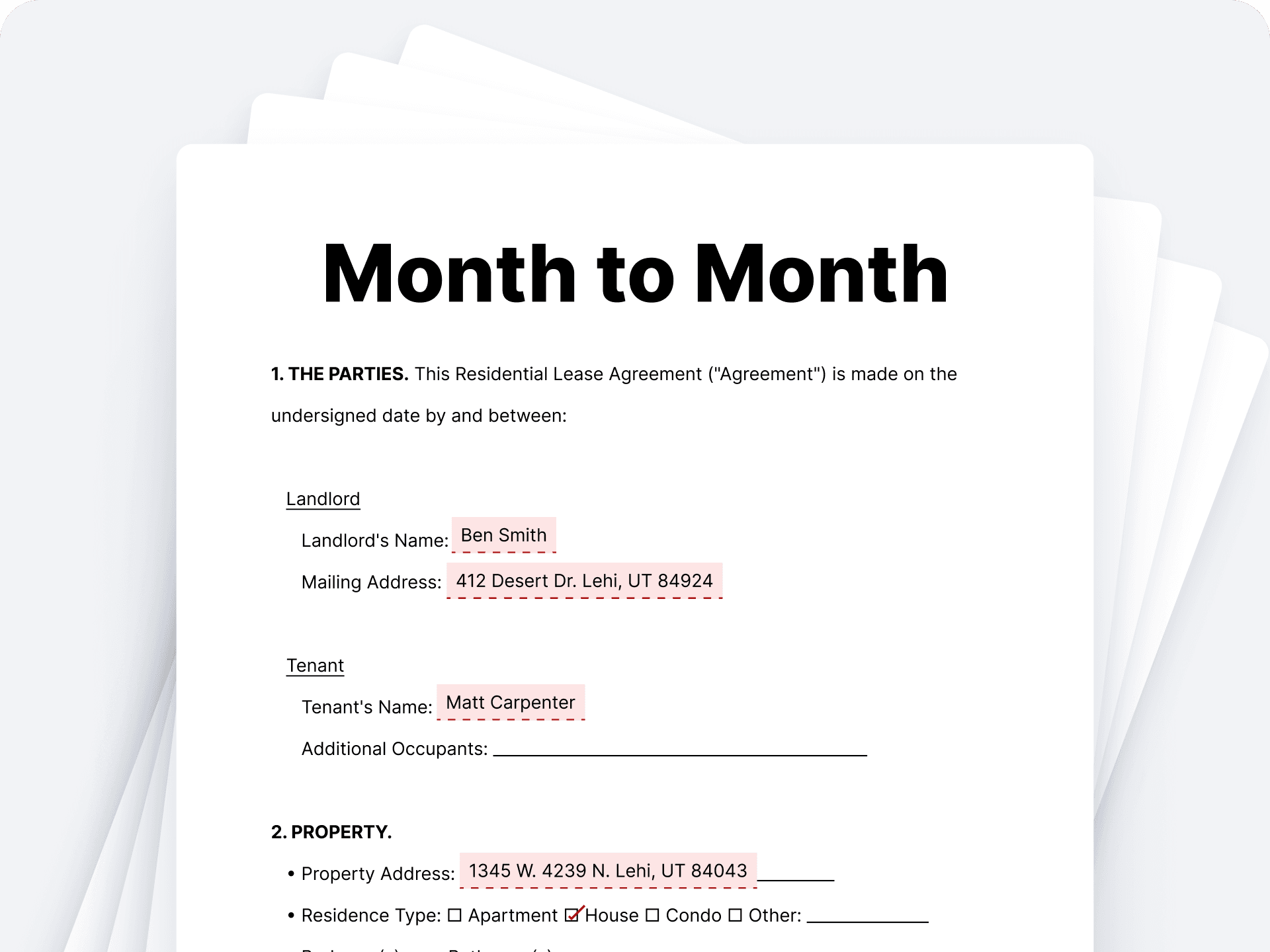Month-to-Month
A month-to-month lease agreement creates a flexible rental contract that continues monthly until either landlords or tenants provide proper termination notice. Unlike fixed-term leases, which bind both parties to set periods (typically 12 months), monthly agreements offer greater flexibility for housing arrangements. This arrangement allows tenants to relocate with short notice—commonly 30 days—while giving landlords the ability to adjust terms such as rent or end agreements with appropriate notice, as state law dictates.
By State
Essential Components of Month-to-Month Lease Agreements
- Landlord: The property owner or authorized manager
- Tenant: The individual or family renting the space
- Term: Ongoing arrangement, renewing monthly until terminated
- Rent Amount: Monthly payment due on a specified date
- Security Deposit: Funds held to cover potential damage or unpaid rent
- Notice Period: Required advance notice to end the lease (typically 30 days)
- Utilities: Clear specification of who pays for water, gas, internet, and electricity
- Occupancy Limits: Defines authorized residents for the property
- Property Rules: Comprehensive coverage of pets, smoking, and maintenance policies
- Termination Clause: Detailed process for ending agreements by either party
- Renewal Options: Clarification of automatic renewal or renegotiation procedures
Benefits of Choosing Month-to-Month Leases
- Enhanced Flexibility: Perfect for tenants who may need to relocate quickly
- Simple Exit Strategy: Landlords can end tenancies for renovations, sales, or new tenants
- No Long-Term Commitment: Especially valuable for short stays or location testing
- Income Optimization: Landlords can adjust rent more frequently to match market rates
Popular Applications for Month-to-Month Leases
- Transitional housing during life changes
- Temporary work relocations and assignments
- Tenants awaiting mortgage approval for home purchases
- Property owners between long-term tenant arrangements
- Additionally, seasonal vacation rentals and short-term accommodations
- Shared housing arrangements with room rentals
Step-by-Step Guide to Creating Month-to-Month Lease Agreements
Step 1: Collect Landlord and Tenant Information. First, gather complete legal names and current addresses for all parties involved.
Step 2: Document Property Details. Next, record the full address, unit number, and residence type (house, apartment, or condo).
Step 3: Establish Lease Start Date. Then, clearly specify when the agreement begins and becomes legally effective.
Step 4: Define Monthly Rent Terms. Moreover, include the exact amount due, preferred payment methods, and specific due dates.
Step 5: Include Security Deposit Information. Additionally, specify the deposit amount and detailed return process requirements.
Step 6: Clarify Utility Responsibilities. Furthermore, identify which utilities are included and designate payment responsibilities for each party.
Step 7: Establish Termination Procedures. Typically, both parties must provide 30-day written notice for lease termination.
Step 8: Create Property Rules. Also, develop comprehensive guidelines for noise levels, pet policies, guest restrictions, and cleanliness standards.
Step 9: Add Entry and Inspection Clauses. Therefore, specify legal conditions and advance notice requirements for landlord property access.
Step 10: Include Dispute Resolution Methods. Finally, outline conflict resolution procedures (such as mediation or court proceedings).
Finalizing and Executing Month-to-Month Lease Agreements
- First, carefully review the complete lease document for accuracy and legal compliance
- Subsequently, convert to PDF format or utilize electronic signature platforms for convenience
- Then, distribute copies to both tenants and landlords for signature collection
- Finally, ensure each party retains signed copies for their records and future reference needs
Legal Considerations for Month-to-Month Agreements
Understanding state and local laws is crucial for creating enforceable month-to-month lease agreements. Moreover, rental regulations vary significantly between jurisdictions, affecting notice periods, rent increase limitations, and eviction procedures. Therefore, consulting local housing authorities or legal professionals helps ensure compliance with applicable laws and protections for both parties.
How to Finalize and Send a Month-to-Month Lease Agreement
- Review the entire lease for accuracy.
- Export as a PDF or use an e-signature platform.
- Send to the tenant and landlord for signatures.
- Each party should keep a signed copy for their records.
